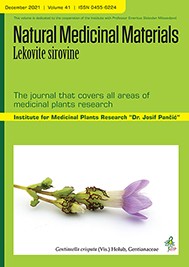Institute for Medicinal Plants Research “Dr. Josif Pančić” , Belgrade , Serbia
Institute for Medicinal Plants Research “Dr. Josif Pančić” , Belgrade , Serbia
Institute for Medicinal Plants Research “Dr. Josif Pančić” , Belgrade , Serbia
Institute for Medicinal Plants Research “Dr. Josif Pančić” , Belgrade , Serbia
Institute for Medicinal Plants Research “Dr. Josif Pančić” , Belgrade , Serbia
Institute for Medicinal Plants Research “Dr. Josif Pančić” , Belgrade , Serbia
Willowherb (Epilobium angustifolium L.) leaves are a valuable source of polyphenolic compounds (phenolic acids, flavonoids, and ellagitannins) that are mainly used in the treatment of benign prostatic hyperplasia. In the presented study, the impacts of maltodextrin and whey protein as carriers on the efficiency of spray drying and physicochemical properties of the obtained powders were examined. The use of carriers significantly improved the drying yield (over 60 %). Moisture content, hygroscopicity, and rehydration time of all dried extracts (without the carrier, with maltodextrin and whey protein) were at an acceptable level, while their flowability and cohesiveness were poor. The encapsulation efficiency of polyphenols in a whey protein carrier of 92.02 % was significantly higher compared to 75.80 % for maltodextrin. These results show that whey protein efficiently encloses the extract ingredients into powder particles and thus preserves sensitive phenolic compounds during the drying process. The efficacy of flavonoid encapsulation was also high (93.00 % for maltodextrin and 94.34 % for whey protein), with no statistically significant differences between carrier types. Therefore, willowherb leaves extract can be successfully encapsulated by spray drying using maltodextrin and whey protein as carriers.
This is an open access article distributed under the Creative Commons Attribution License which permits unrestricted use, distribution, and reproduction in any medium, provided the original work is properly cited.

The statements, opinions and data contained in the journal are solely those of the individual authors and contributors and not of the publisher and the editor(s). We stay neutral with regard to jurisdictional claims in published maps and institutional affiliations.